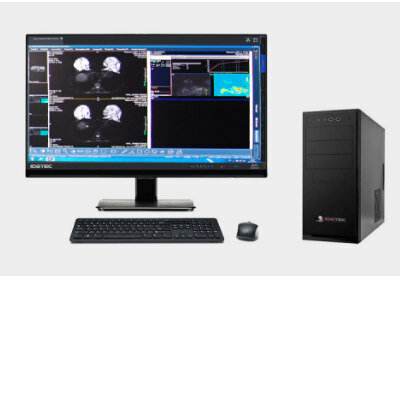New Type of MRI Could Evaluate Plaque in Blood Vessels
By MedImaging International staff writers
Posted on 26 Aug 2008
Physicists who recently have invented a new type of magnetic resonance imaging (MRI) technique reported that this advance might ultimately enable the development of extremely small computers, and even give clinicians a new tool for evaluating the plaque in blood vessels that play a role in diseases such as heart disease.Posted on 26 Aug 2008
In the July 18, 2008, issue of the journal Physical Review Letters, the scientists reported the first-ever MR image of the inside of an extremely tiny magnet. "The magnets we study are basically the same as a refrigerator magnet, only much smaller,” said project leader Chris Hammel, Ohio Eminent Scholar in Experimental Physics at Ohio State University (Columbus, USA). The disk-shaped magnets in this study measured only two micrometers across. "Because ferromagnets generate such strong magnetic fields, we can't study them with typical MRI. A related technique, ferromagnetic resonance, or FMR, would work, but it's not sensitive enough to study individual magnets that are this small.”
Similarly, medical researchers cannot use MRI to image plaques formed in the body, because plaques are too small. This is why this new kind of MRI could eventually become a tool for biomedical research. The technique combines three different kinds of technology: MRI, FMR, and atomic force microscopy.
The investigators called the technique scanned probe ferromagnetic resonance force microscopy, or scanned probe FMRFM, and it involves detecting a magnetic signal using a tiny silicon bar with an even tinier magnetic probe on its tip. As the probe passes over a material, it captures a bowl-shaped image: a curved cross-section of an object. The magnetic signal is more intense in the middle (the "bottom” of the bow"), and fades away toward the edges.
This may appear like an odd configuration, but that is why the new technique works.
Every atom emits radio waves at a particular frequency. But to know where those atoms are, scientists need to be able to localize where the radio waves are coming from; similar to the way in which large-scale hospital-type MRI machines get around this problem by varying the magnetic field by precise amounts as it sweeps over an object. The computer controlling the MRI knows where the magnetic field equals X, the location equals Y; advanced software combines the data, and clinicians obtain a three-dimensional (3D) view inside a patient's body.
For Dr. Hammel's tiny magnets, no techniques were previously known that would image the inside of them, much less allow for precise localization. But since the new probe system generates a magnetic field that varies naturally, the physicists discovered that they could sweep the probe over an array of magnets and obtain a 2D view that's similar to a medical MRI.
In the published study, the researchers reported an image resolution of 250 nanometers. Now that they have their imaging technique, Dr. Hammel and his coworkers are beginning to record the characteristics of many different kinds of tiny magnets--a crucial first step toward developing them for computer memory. Experts believe that one day, tiny magnets could be "implanted” on a computer's central processing unit (CPU) chip. Because system data could be recorded on the magnets, such a computer would never need to boot up as its memory would persist. It would also be very small; essentially, the entire computer could be contained in the CPU.
For biomedical research purposes, the technique could be used to examine tissue samples taken from plaques that form in brain tissues and arteries in the body. Many diseases are associated with plaques, including Alzheimer's and atherosclerosis. Currently, researchers are trying to assess the structure of plaques in detail to better determine how they form and how they affect traditional MRI images.
Dr. Hammel and his team hope to contribute to the development of an instrument that could be sold and used routinely in laboratories. But the technique needs some further development before it could become an everyday tool for the computer industry or for biomedicine.
Related Links:
Ohio State University














